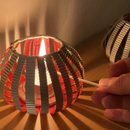Introduction: Automated Bonsai Watering With Salvaged 18650 Cells
This Instructable is the second project in a miniseries about an automated watering system for Bonsai trees or plants. The first part showed the construction of a system including a digital weekly programmable time switch and a peristaltic pump and can be found under the following link (Episode 1). A disadvantage of the system was that it required a power supply next to your plant. Therefore this current project is about to replace the power supply by a battery pack to make the system completely stand-alone without a water connection or a power supply. Since the programmable time switch requires 12 Volts, three 18650 Lithium type batteries in series salvaged from an old laptop battery pack were chosen. When in operation for one minute a day the system can run on batteries for one month.
Step 1: General Design
As explained in the first project the principle of this watering system is not to use a conductivity sensor placed in the soil to start watering but to use a timer with fixed watering intervals. Time dependent intervals with Arduino are not that easy because you need to have an own clock module like a DS3231 element, a keypad to enter data and of course a display. Furthermore, you need to make all the coding and in the case of power failure you lose all your variable settings. Therefore, an ideal solution is an industrial timer which has its own built-in back up battery. It includes a display and the keypad for data entry. On top this unit comes with a prize in the range of 6 US $ and therefore sounded interesting. Don’t get me wrong – I love Arduinos but since my coding skills are limited I thought that this way would lead to a faster project end.
The prototype of this setup here is successfully running for two years now. The tank has enough volume to store water for 2 month when a one minute watering time is used per day. There is no need any more to ask your neighbor or your kids to water your plant when you are abroad.
However due to the light requirements one would like to have the plant upon a window board. So the plant can catch as much sunlight as possible. But often this place has no power supply nearby or a long cable is just not nice looking. Therefore a battery pack was designed from three 18650 batteries connected in series. Lithium cells do require a Battery Management System (BMS). The BMS protects the batteries from being overcharged and on the other hand the system protects the cells from being discharged below a critical voltage. The three batteries are charged by using an old power supply from a laptop providing around 19 Volts. To reduce the voltage to the required maximal voltage of the BMS (12.6V) a step down converter was installed. The entire setup was connected using socket terminal strips in order to be flexible to change batteries or test a different BMS.
Step 2: Parts List
The parts you need for the watering systems are not listed again. They can be found under the following link: Episode 1. The parts you need for the “power bank” are the following:
1. Step Down Converter (XL4005 DSN5000 beyond LM2596 DC-DC adjustable step-down 5A power supply module, AliExpress 1.04 US $): This component is needed to regulate the voltage from the power supply down from 19V to 12.6V as input for the BMS.
2. Battery Management System (20A Li-ion Lithium Battery 18650 Charger 12.6V Cell 64x20x3.4mm Module PCB BMS Protection Board, AliExpress 1.50 US $): This component is needed to protect the batteries from being overcharged and on the other hand the system protects the cells from being discharged below a critical voltage.
3. Battery holders (18650 Battery 3.7V Clip Holder Box Case Black with wire, AliExpress 0.3 US $): This component is needed for an easy connection of the batteries. The holder boxes allow for an exchange of batteries with different capacities.
4. Switch (10*15mm SPST 2PIN ON/OFF G130 Boat Rocker Switch 3A/250V, AliExpress 0.1 US $). This component is used to disconnect the Step Down Converter after charging the batteries from the circuit in order to save power.
5. Power Female Plug Connector (PHISCALE DC Power Female plug Connector 5.5*2.1 / 5.5x2.1mm Adapter Plastic Handle Short Black Head, Aliexpress 0.3 US $): This component is needed as a connection to the watering system.
6. Power socket connector (5.5*2.1 / 5.5 x 2.1 mm DC Power Socket/ DC Connector DC-053, Aliexpress 0.7 US $): This component is used to connect the power supply to the circuit for charging.
7. Socket-terminal strips: In order to be flexible and to be able to test different kinds of Battery Management Systems Socket-terminal strips are use.
Additional parts and tools:
· Hot glue gun
· Scrap wood
· Foam rubber
· Screws
· Soldering station
· Voltage meter
Step 3: Wiring Diagram
First solder all wires to the Battery Management System (BMS). Then fix the battery holders to the mounting plate with hot glue. Use socket-terminal strips as connector between the single batteries and the BMS. Attach the switch, the step down converter, the power connector and the female plug connector. Connect the power supply and measure the voltage with a voltage meter. Adjust the voltage with a screw driver to 12.6 Volts as required by the BMS. Now insert the batteries into the holders.
Step 4: Housing
The mounting plate with the “power bank” is glued onto the bottom plate. The system then can be placed under the water tank.
Step 5: Combine Everything
Connect the battery power with the watering system and program the timer according to the requirements of your plant.













